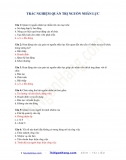Thông tin tài liệu
TABLE OF CONTENT ACKNOWLEDGEMENT PART I: INTRODUCTION 1. Rationale 2. Aims of the study 3. Research questions 4. Methods of the study 5. Design of the study PART II: DEVELOPMENT CHAPTER I: THEORETICAL BACKGROUND 1. Bilingualism 1.1. Defining 1.2. Bilingual education – the reason it should be required 1.3. The age which is suitable for bilingual learning 2. Comparing bilingual to monolingual learning 2.1. Bilingual 2.1.1. Advantages 2.1.2. Disadvantages 2.2. Monolingual 2.2.1. Advantages 2.2.2. Disadvantages 3. The objective and subjective influences on bilingual learning 3.1. Objectivity 3.2. Subjectivity CHAPTER II: METHODOLOGY 1. Sample and sampling 2. Instruments 3. Data collection 4. Data analysis CHAPTER III: DATA ANALYSIS, FINDINGS AND SUGGESTED SOLUTIONS 1. Data analysis and findings 2. Bilingual models are taught at Hai Phong Management and Technology University 3. Difficulties of bilingual learning at Hai Phong Management and Technology University 3.1. Knowledge 3.1.1. Grammar 3.1.2. Vocabulary 3.1.3. Pronunciation 3.2. The skills 4. Suggested solutions 4.1. Write diary 4.2. Reading 4.3. Listening 4.4. Set goals PART III: CONCLUTION SURVEY QUESTIONAIRE REFERENCE
Xem thêm


 ThiNganHang Sách - Tài liệu thi tuyển
ThiNganHang Sách - Tài liệu thi tuyển









